Home / The Retro Diels-Alder Reaction
Dienes and MO Theory
The Retro Diels-Alder Reaction
Last updated: February 17th, 2023 |
Mechanism and Examples of the Retro Diels-Alder Reaction
In the last post in this series on the Diels-Alder [See: Diels-Alder Reaction: Kinetic and Thermodynamic Control] we saw that if you apply enough heat, the Diels-Alder can operate in both the forward and reverse directions!
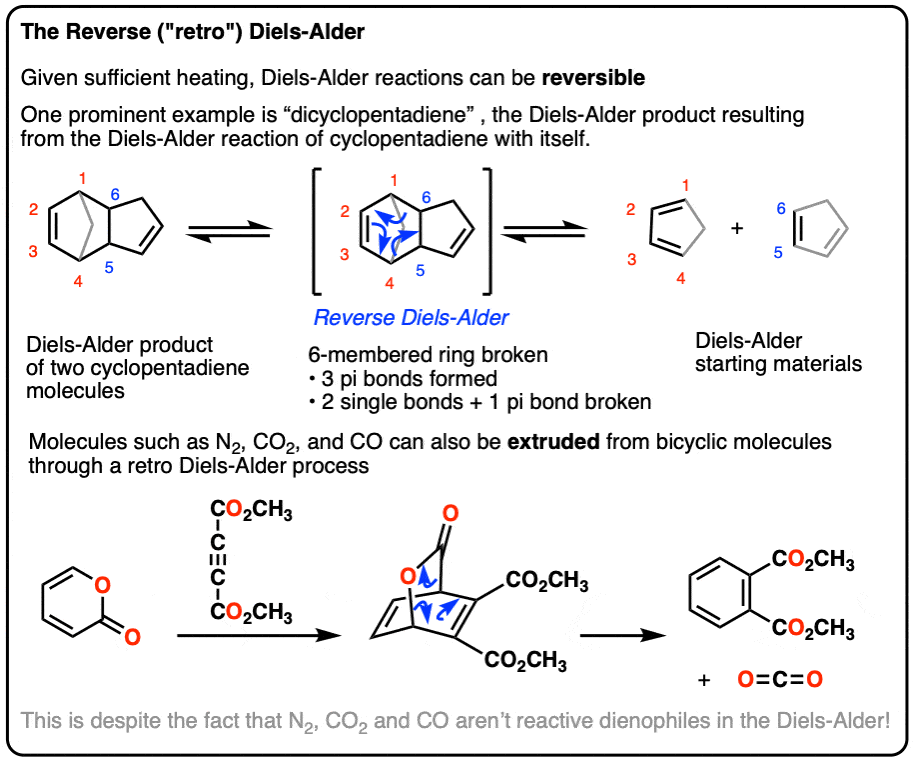
Table of Contents
- What Is The “Retro” Diels-Alder Reaction
- Diels-Alder / Retro Diels-Alder Reactions With Pyrone
- The Retro Diels-Alder Of This Molecule Does Not Give Back The Original Reactants!
- The Pyrone Retro Diels-Alder Is Particularly Favorable Because It Generates An Aromatic Ring And Liberates CO2
- Summary: The Retro Diels-Alder Reaction
- (Advanced) References and Further Reading
1. What Is The “Retro” Diels-Alder Reaction?
The “retro-Diels Alder” reaction is the exact reverse of the Diels-Alder and passes through the same transition state. (We sometimes say it’s the “microscopic” reverse – if you were to play a film of the Diels-Alder reaction occurring, and then reverse the film, it would be indistinguishable from the retro-Diels Alder reaction).
In the most common case, where the reverse Diels-Alder is exactly the same as the forward Diels-Alder, all that really happens is that an equilibrium is established between the diene/dienophile and the Diels-Alder product.
However, there are cases where the Diels-Alder product can undergo more than one possible retro-Diels Alder reaction, and this can result in the formation of products that differ from the “original” diene and dienophile.
This situation doesn’t come up very often in introductory organic chemistry courses, but when it does, it’s usually when you’re sitting in an exam hall. What makes the retro-Diels Alder reaction exam-question catnip for instructors is that it asks you to apply concepts you already know, but in the reverse direction.
Here, we’ll go through a classic example of a retro-Diels Alder reaction that shows how the reaction can be used to make useful new products, instead of just reverting to the starting diene and dienophile. (And if that isn’t enough, there’s a bonus, second example of a retro-Diels Alder in the supplemental section ).
2. Diels-Alder / Retro-Diels-Alder Reactions With Pyrone
Pyrone (specifically 2-Pyrone) is a cyclic molecule that resembles benzene but is not actually aromatic. Locked in the s-cis conformation, pyrone will participate in the Diels-Alder reaction with dienophiles. For reasons that will soon be clear, a useful category of dienophile is electron-poor alkynes such as dimethylacetylene dicarboxylate (DMAD), which results in the following Diels-Alder reaction:

The “top view” (above) shows the new six-membered ring as outlined from the (arbitrary) numbering scheme. It’s also possible to draw the same molecule from the side, which shows this bridged bicyclic molecule in perspective [See: Putting Diels-Alder Products in Perspective ]
3. The Retro Diels-Alder Of This Molecule Does Not Give Back The Original Reactants!
Now comes the fun part.
When this Diels-Alder product is heated, a retro-Diels Alder reaction occurs, but the final product isn’t 2-pyrone and the alkyne dienophile!
Instead, the products are a new aromatic ring and carbon dioxide (CO2)!
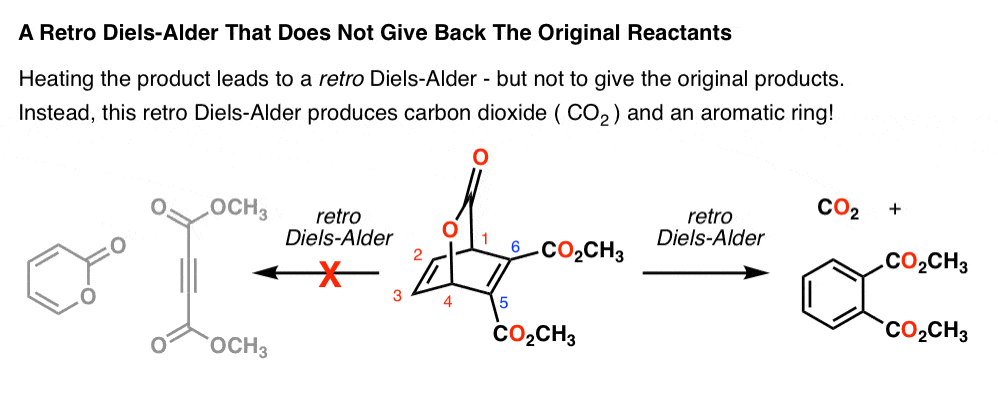
Why doesn’t it fragment to give back the pyrone and alkyne?
Well, it’s possible that it does, to some extent (more on that in a second). But the main point is that more than one retro-Diels-Alder pathway is possible here!
The second six-membered ring that can undergo retro-Diels Alder fragmentation is highlighted in red below:
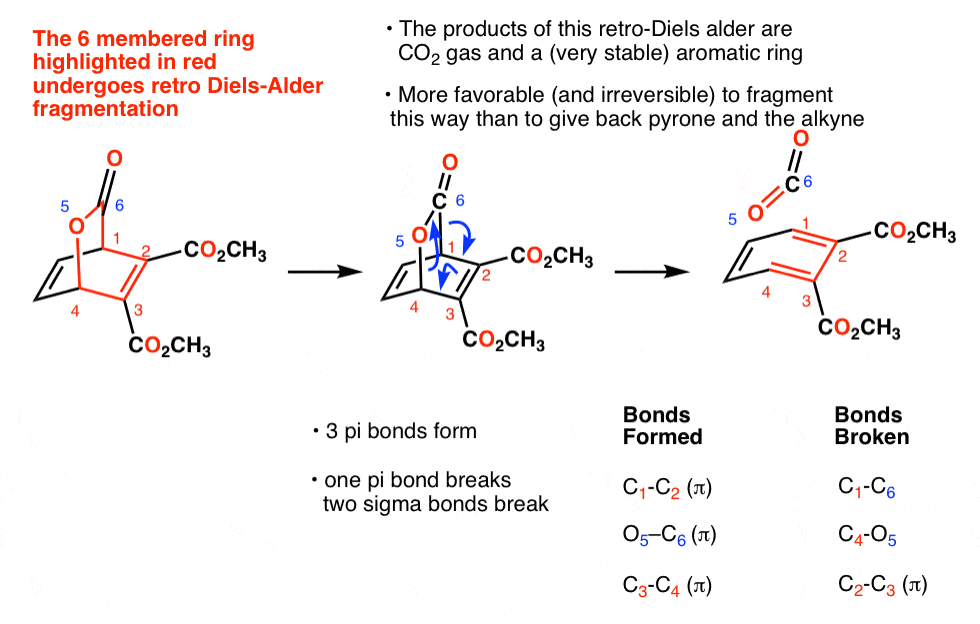
4. The Pyrone Retro Diels-Alder Reaction Is Favorable Because It Generates An Aromatic Ring And Liberates CO2
Note that this retro-Diels Alder involves the same pattern of bond formation and bond breaking as in the retro-Diels Alder reaction at the top of the article:
- three pi bonds are formed
- two sigma bonds and one pi bond is broken
(One difference is that one of the pi bonds that forms is a C–O pi bond instead of a C–C pi bond, which technically makes it a retro-“hetero”-Diels Alder. A hetero Diels-Alder is a Diels Alder reaction that incorporates a heteroatom (i.e. non-carbon atom) such as oxygen or nitrogen into the new six-membered ring. )
What makes this particular retro-Diels Alder favorable, relative to the retro-Diels Alder that regenerates the pyrone and alkyne?
- First, the products are particularly stable. In addition to liberating CO2, the reaction also produces a new six membered ring with a property known as aromaticity that makes it particularly stable (about 36 kcal/mol more stable than would be expected based on bond energies alone).
- Secondly, this particular retro-Diels Alder reaction is irreversible, since the CO2 that is released is a notoriously poor dienophile for Diels-Alder reactions. Even if the retro-Diels Alder to generate the alkyne and pyrone does occur, equilibrium will eventually drive the reaction mixture towards formation of the aromatic ring and CO2.
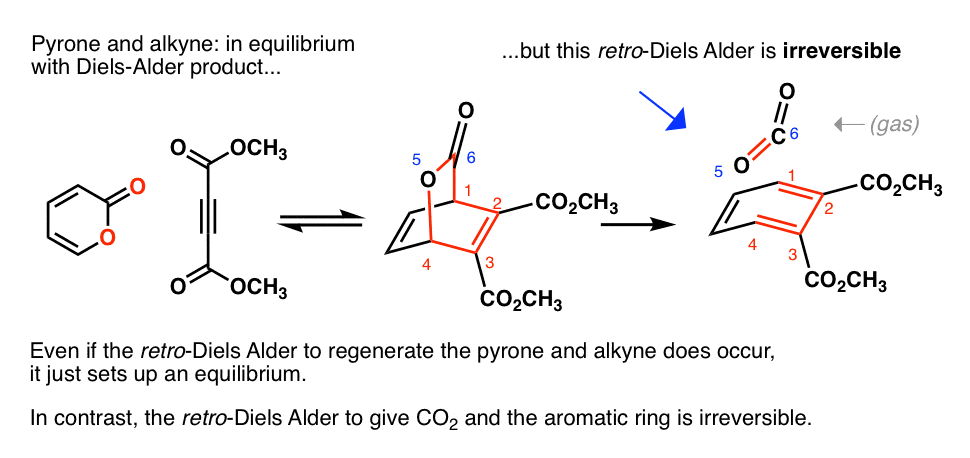
See the supplementary section for a clever example of a pyrone / alkyne Diels-Alder reaction.
5. Summary: The Retro Diels-Alder Reaction
The retro-Diels Alder reaction is the microscopic reverse of the Diels-Alder reaction. It has the same transition state as the Diels-Alder, but as we saw in the previous post, requires more heating (i.e. has a higher energy barrier) than the forward Diels-Alder process.
When a retro-Diels Alder reaction just causes the Diels-Alder product to revert to the starting diene and dienophile, that’s essentially just setting up an equilibrium between the reactants and product.
However, by using certain cleverly designed reaction partners, some Diels-Alder products can undergo a retro-Diels Alder that irreversibly leads to new products, usually liberating a gas and an aromatic ring. The most common example is in the use of pyrone as diene with an acetylene as a dienophile, but there are others (see bonus section, below).
Notes
Related Articles
- The Intramolecular Diels Alder Reaction
- Diels-Alder Reaction: Kinetic and Thermodynamic Control
- Regiochemistry In The Diels-Alder Reaction
- HOMO and LUMO In the Diels Alder Reaction
- Thermodynamic and Kinetic Products
- Exo vs Endo Products In The Diels Alder: How To Tell Them Apart
- Why Are Endo vs Exo Products Favored in the Diels-Alder Reaction?
- Stereochemistry of the Diels-Alder Reaction
Diels-Alder / Retro Diels Alder Reactions of Tetrazines (Loss of N2)
This could be a bad analogy, but the retro-Diels Alder reminds me a little bit of the famous “adrenaline shot” scene in Pulp Fiction.
Why? Rather than have John Travolta stab Uma Thurman in the chest with a syringe, Tarantino filmed Travolta pulling the needle out of Thurman’s chest, and then reversed the footage.
The reverse process had a lower activation barrier for all concerned, particularly Uma Thurman.
Another example of a retro-Diels Alder that generates a new product begins with a class of very electron-poor diene called tetrazines.
When tetrazine is combined with a electron-rich acetylene like diphenylacetylene, a new Diels-Alder product results. (This puts the shoe on the other foot, energetically – the diene is electron poor, and the dienophile is electron rich! These reactions are called “inverse-electron demand Diels Alder reactions“, and although less frequently observed than their “normal electron demand” cousins, still see a lot of use. )
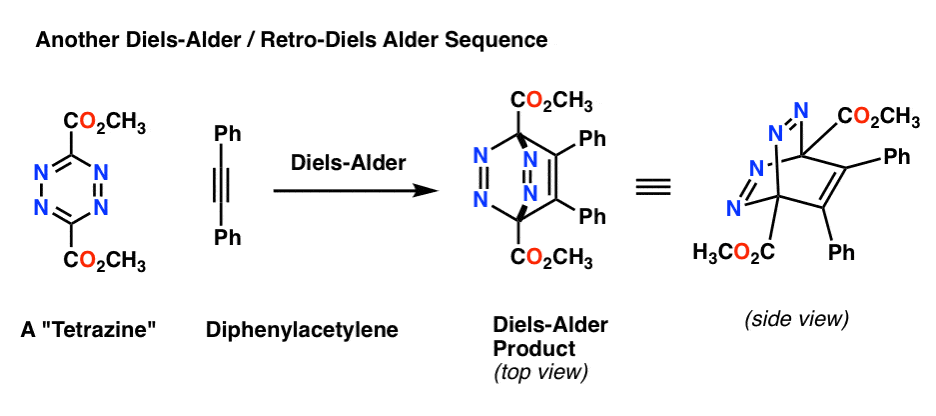
When this Diels-Alder product is heated, it undergoes a retro-Diels Alder reaction, losing N2 and forming a new aromatic ring:
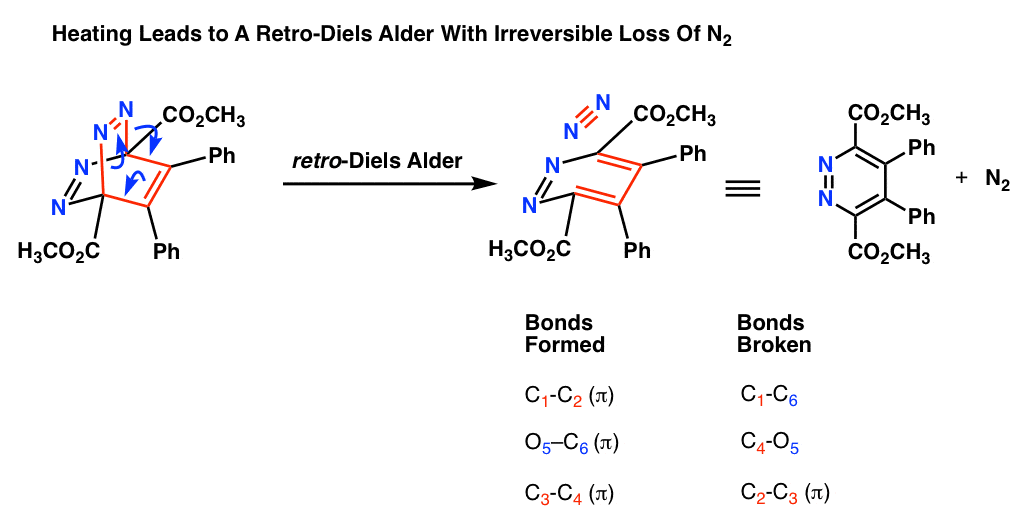
With a few exceptions (mostly involving reactions with metals) nitrogen gas is completely inert.
The product can even be induced to undergo a second Diels-Alder / retro-Diels-Alder reaction (with loss of a second molecule of nitrogen).
Dale Boger’s group at Scripps has been extremely active in coming up with inventive applications of the retro-Diels Alder reaction, which you can read about in more detail here (Aldrich).
Sometimes the retro-Diels Alder is like that beautiful, rarely-used tool in a mechanic’s shop that is perfect for a very specific job.
A few years ago the Baran research group (also at Scripps) faced a problem where they were trying to form a medium-sized, highly strained ring in the molecule Haouamine A, which featured a “bent” aromatic ring. After banging their heads against the wall trying all of the conventional approaches to ring formation, they eventually solved the problem through bringing together an alkyne and a pyrone in an intramolecular Diels-Alder reaction, followed by a retro Diels-Alder to generate the aromatic ring. This required heating in a sealed tube at 250°C for 10h, which gave them the product in 21% yield along with 30% recovered starting material. (they later came up with higher-yielding approaches toward synthesizing the ring).
The reaction scheme is drawn up here on Hans J. Reich’s organic chemistry site (free) ; full paper here.
(Advanced) References and Further Reading
- Derivatives of Hemimellitic Acid. A Synthesis of Erythrocentaurin
Ernest Wenkert, David B. R. Johnston, and K. G. Dave
The Journal of Organic Chemistry 1964, 29 (9), 2534-2542
DOI: 1021/jo01032a012
This paper uses the Diels-Alder-retro-Diels-Alder domino reaction to generate Hemimellitic acid and its derivatives, which are used in total synthesis. - Diels-Alder reactions of 2-pyrones. Direction of the addition reaction with acetylenes
Joe A. Reed, Curtis L. Schilling Jr., R. F. Tarvin, Thomas A. Rettig, and John K. Stille
The Journal of Organic Chemistry 1969, 34 (7), 2188-2192
DOI: 1021/jo01259a035
This paper is more concerned with the first step – addition of the alkyne (e.g. DMAD) to 2-pyrone. Note the author – this is the same John Stille of Stille reaction fame. - Recent developments in the retro-Diels–Alder reaction
Sambasivarao Kotha and Shaibal Banerjee
RSC Advances 2013, 3, 7642-7666
DOI: 1039/C3RA22762F - Retro-Diels-Alder Reaction. Part I. C-C Dienophiles
Bruce Rickborn
Organic Reactions 1998, 52, 1-393
DOI: 1002/0471264180.or052.01 - The Retro–Diels–Alder Reaction Part II. Dienophiles with One or More Heteroatom
Bruce Rickborn
Organic Reactions 1998, 53, 223-629
DOI: 1002/0471264180.or053.02 - Photo Retro-Diels–Alder Reactions
Valentine K. Johns, Zheng Shi, Wei Dang, Matthew D. McInnis, Yuxiang Weng, and Yi Liao
The Journal of Physical Chemistry A 2011, 115 (28), 8093-8099
DOI: 10.1021/jp202063m
Retro-Diels-Alder reactions can also be initiated by light, as this paper demonstrates. - Total Synthesis of (±)-Haouamine A
Phil S. Baran and and Noah Z. Burns
Journal of the American Chemical Society 2006, 128 (12), 3908-3909
DOI: 10.1021/ja0602997
The final step in the total synthesis of (±)-Haouamine A is a tandem Diels-Alder-Retro-Diels Alder reaction. The paper states, “After extensive experimentation, 15 was converted into 1 [(±)-Haouamine A] upon microwave irradiation of 15 in dichlorobenzene at 250 °C for 10 h followed by basic (K2CO3, MeOH) acetate hydrolysis.”
On another note, Noah Burns is now a professor at Stanford University, and I remember reading his first paper as an assistant professor back in 2013, which was an elegant method for asymmetric dibromination of alkenes, ala K. B. Sharpless. - Retro Diels-Alder Reactions
Hans J. Reich (U. Wisconsin-Madison) has a website chock full of useful information on organic chemistry, including this section on Retro-Diels-Alder reactions. Another one can be found here: - Diels-alder reactions with inverse electron demand. II. The reaction of benzamidine with π-deficient heteroaromatic compounds
P. Figeys, A. Mathy
Tet. Lett. 1981, 22 (15), 1393-1396
DOI: 10.1016/S0040-4039(01)90330-2
The normal Diels-Alder reaction proceeds best when the diene is electron-rich and the dienophile electron-poor. However, in certain cases, the opposite polarity is possible, and these reactions are known as inverse electron-demand Diels-Alder reactions. - Inverse Electron-Demand Diels Alder Reactions
This technical article by Sigma-Aldrich has a lot of useful information on inverse-electron-demand Diels-Alder reactions.
00 General Chemistry Review
01 Bonding, Structure, and Resonance
- How Do We Know Methane (CH4) Is Tetrahedral?
- Hybrid Orbitals and Hybridization
- How To Determine Hybridization: A Shortcut
- Orbital Hybridization And Bond Strengths
- Sigma bonds come in six varieties: Pi bonds come in one
- A Key Skill: How to Calculate Formal Charge
- The Four Intermolecular Forces and How They Affect Boiling Points
- 3 Trends That Affect Boiling Points
- How To Use Electronegativity To Determine Electron Density (and why NOT to trust formal charge)
- Introduction to Resonance
- How To Use Curved Arrows To Interchange Resonance Forms
- Evaluating Resonance Forms (1) - The Rule of Least Charges
- How To Find The Best Resonance Structure By Applying Electronegativity
- Evaluating Resonance Structures With Negative Charges
- Evaluating Resonance Structures With Positive Charge
- Exploring Resonance: Pi-Donation
- Exploring Resonance: Pi-acceptors
- In Summary: Evaluating Resonance Structures
- Drawing Resonance Structures: 3 Common Mistakes To Avoid
- How to apply electronegativity and resonance to understand reactivity
- Bond Hybridization Practice
- Structure and Bonding Practice Quizzes
- Resonance Structures Practice
02 Acid Base Reactions
- Introduction to Acid-Base Reactions
- Acid Base Reactions In Organic Chemistry
- The Stronger The Acid, The Weaker The Conjugate Base
- Walkthrough of Acid-Base Reactions (3) - Acidity Trends
- Five Key Factors That Influence Acidity
- Acid-Base Reactions: Introducing Ka and pKa
- How to Use a pKa Table
- The pKa Table Is Your Friend
- A Handy Rule of Thumb for Acid-Base Reactions
- Acid Base Reactions Are Fast
- pKa Values Span 60 Orders Of Magnitude
- How Protonation and Deprotonation Affect Reactivity
- Acid Base Practice Problems
03 Alkanes and Nomenclature
- Meet the (Most Important) Functional Groups
- Condensed Formulas: Deciphering What the Brackets Mean
- Hidden Hydrogens, Hidden Lone Pairs, Hidden Counterions
- Don't Be Futyl, Learn The Butyls
- Primary, Secondary, Tertiary, Quaternary In Organic Chemistry
- Branching, and Its Affect On Melting and Boiling Points
- The Many, Many Ways of Drawing Butane
- Wedge And Dash Convention For Tetrahedral Carbon
- Common Mistakes in Organic Chemistry: Pentavalent Carbon
- Table of Functional Group Priorities for Nomenclature
- Summary Sheet - Alkane Nomenclature
- Organic Chemistry IUPAC Nomenclature Demystified With A Simple Puzzle Piece Approach
- Boiling Point Quizzes
- Organic Chemistry Nomenclature Quizzes
04 Conformations and Cycloalkanes
- Staggered vs Eclipsed Conformations of Ethane
- Conformational Isomers of Propane
- Newman Projection of Butane (and Gauche Conformation)
- Introduction to Cycloalkanes
- Geometric Isomers In Small Rings: Cis And Trans Cycloalkanes
- Calculation of Ring Strain In Cycloalkanes
- Cycloalkanes - Ring Strain In Cyclopropane And Cyclobutane
- Cyclohexane Conformations
- Cyclohexane Chair Conformation: An Aerial Tour
- How To Draw The Cyclohexane Chair Conformation
- The Cyclohexane Chair Flip
- The Cyclohexane Chair Flip - Energy Diagram
- Substituted Cyclohexanes - Axial vs Equatorial
- Ranking The Bulkiness Of Substituents On Cyclohexanes: "A-Values"
- Cyclohexane Chair Conformation Stability: Which One Is Lower Energy?
- Fused Rings - Cis-Decalin and Trans-Decalin
- Naming Bicyclic Compounds - Fused, Bridged, and Spiro
- Bredt's Rule (And Summary of Cycloalkanes)
- Newman Projection Practice
- Cycloalkanes Practice Problems
05 A Primer On Organic Reactions
- The Most Important Question To Ask When Learning a New Reaction
- Learning New Reactions: How Do The Electrons Move?
- The Third Most Important Question to Ask When Learning A New Reaction
- 7 Factors that stabilize negative charge in organic chemistry
- 7 Factors That Stabilize Positive Charge in Organic Chemistry
- Nucleophiles and Electrophiles
- Curved Arrows (for reactions)
- Curved Arrows (2): Initial Tails and Final Heads
- Nucleophilicity vs. Basicity
- The Three Classes of Nucleophiles
- What Makes A Good Nucleophile?
- What makes a good leaving group?
- 3 Factors That Stabilize Carbocations
- Equilibrium and Energy Relationships
- What's a Transition State?
- Hammond's Postulate
- Learning Organic Chemistry Reactions: A Checklist (PDF)
- Introduction to Free Radical Substitution Reactions
- Introduction to Oxidative Cleavage Reactions
06 Free Radical Reactions
- Bond Dissociation Energies = Homolytic Cleavage
- Free Radical Reactions
- 3 Factors That Stabilize Free Radicals
- What Factors Destabilize Free Radicals?
- Bond Strengths And Radical Stability
- Free Radical Initiation: Why Is "Light" Or "Heat" Required?
- Initiation, Propagation, Termination
- Monochlorination Products Of Propane, Pentane, And Other Alkanes
- Selectivity In Free Radical Reactions
- Selectivity in Free Radical Reactions: Bromination vs. Chlorination
- Halogenation At Tiffany's
- Allylic Bromination
- Bonus Topic: Allylic Rearrangements
- In Summary: Free Radicals
- Synthesis (2) - Reactions of Alkanes
- Free Radicals Practice Quizzes
07 Stereochemistry and Chirality
- Types of Isomers: Constitutional Isomers, Stereoisomers, Enantiomers, and Diastereomers
- How To Draw The Enantiomer Of A Chiral Molecule
- How To Draw A Bond Rotation
- Introduction to Assigning (R) and (S): The Cahn-Ingold-Prelog Rules
- Assigning Cahn-Ingold-Prelog (CIP) Priorities (2) - The Method of Dots
- Enantiomers vs Diastereomers vs The Same? Two Methods For Solving Problems
- Assigning R/S To Newman Projections (And Converting Newman To Line Diagrams)
- How To Determine R and S Configurations On A Fischer Projection
- The Meso Trap
- Optical Rotation, Optical Activity, and Specific Rotation
- Optical Purity and Enantiomeric Excess
- What's a Racemic Mixture?
- Chiral Allenes And Chiral Axes
- Stereochemistry Practice Problems and Quizzes
08 Substitution Reactions
- Nucleophilic Substitution Reactions - Introduction
- Two Types of Nucleophilic Substitution Reactions
- The SN2 Mechanism
- Why the SN2 Reaction Is Powerful
- The SN1 Mechanism
- The Conjugate Acid Is A Better Leaving Group
- Comparing the SN1 and SN2 Reactions
- Polar Protic? Polar Aprotic? Nonpolar? All About Solvents
- Steric Hindrance is Like a Fat Goalie
- Common Blind Spot: Intramolecular Reactions
- Substitution Practice - SN1
- Substitution Practice - SN2
09 Elimination Reactions
- Elimination Reactions (1): Introduction And The Key Pattern
- Elimination Reactions (2): The Zaitsev Rule
- Elimination Reactions Are Favored By Heat
- Two Elimination Reaction Patterns
- The E1 Reaction
- The E2 Mechanism
- E1 vs E2: Comparing the E1 and E2 Reactions
- Antiperiplanar Relationships: The E2 Reaction and Cyclohexane Rings
- Bulky Bases in Elimination Reactions
- Comparing the E1 vs SN1 Reactions
- Elimination (E1) Reactions With Rearrangements
- E1cB - Elimination (Unimolecular) Conjugate Base
- Elimination (E1) Practice Problems And Solutions
- Elimination (E2) Practice Problems and Solutions
10 Rearrangements
11 SN1/SN2/E1/E2 Decision
- Identifying Where Substitution and Elimination Reactions Happen
- Deciding SN1/SN2/E1/E2 (1) - The Substrate
- Deciding SN1/SN2/E1/E2 (2) - The Nucleophile/Base
- SN1 vs E1 and SN2 vs E2 : The Temperature
- Deciding SN1/SN2/E1/E2 - The Solvent
- Wrapup: The Key Factors For Determining SN1/SN2/E1/E2
- Alkyl Halide Reaction Map And Summary
- SN1 SN2 E1 E2 Practice Problems
12 Alkene Reactions
- E and Z Notation For Alkenes (+ Cis/Trans)
- Alkene Stability
- Alkene Addition Reactions: "Regioselectivity" and "Stereoselectivity" (Syn/Anti)
- Stereoselective and Stereospecific Reactions
- Hydrohalogenation of Alkenes and Markovnikov's Rule
- Hydration of Alkenes With Aqueous Acid
- Rearrangements in Alkene Addition Reactions
- Halogenation of Alkenes and Halohydrin Formation
- Oxymercuration Demercuration of Alkenes
- Hydroboration Oxidation of Alkenes
- m-CPBA (meta-chloroperoxybenzoic acid)
- OsO4 (Osmium Tetroxide) for Dihydroxylation of Alkenes
- Palladium on Carbon (Pd/C) for Catalytic Hydrogenation of Alkenes
- Cyclopropanation of Alkenes
- A Fourth Alkene Addition Pattern - Free Radical Addition
- Alkene Reactions: Ozonolysis
- Summary: Three Key Families Of Alkene Reaction Mechanisms
- Synthesis (4) - Alkene Reaction Map, Including Alkyl Halide Reactions
- Alkene Reactions Practice Problems
13 Alkyne Reactions
- Acetylides from Alkynes, And Substitution Reactions of Acetylides
- Partial Reduction of Alkynes With Lindlar's Catalyst
- Partial Reduction of Alkynes With Na/NH3 To Obtain Trans Alkenes
- Alkyne Hydroboration With "R2BH"
- Hydration and Oxymercuration of Alkynes
- Hydrohalogenation of Alkynes
- Alkyne Halogenation: Bromination, Chlorination, and Iodination of Alkynes
- Alkyne Reactions - The "Concerted" Pathway
- Alkenes To Alkynes Via Halogenation And Elimination Reactions
- Alkynes Are A Blank Canvas
- Synthesis (5) - Reactions of Alkynes
- Alkyne Reactions Practice Problems With Answers
14 Alcohols, Epoxides and Ethers
- Alcohols - Nomenclature and Properties
- Alcohols Can Act As Acids Or Bases (And Why It Matters)
- Alcohols - Acidity and Basicity
- The Williamson Ether Synthesis
- Ethers From Alkenes, Tertiary Alkyl Halides and Alkoxymercuration
- Alcohols To Ethers via Acid Catalysis
- Cleavage Of Ethers With Acid
- Epoxides - The Outlier Of The Ether Family
- Opening of Epoxides With Acid
- Epoxide Ring Opening With Base
- Making Alkyl Halides From Alcohols
- Tosylates And Mesylates
- PBr3 and SOCl2
- Elimination Reactions of Alcohols
- Elimination of Alcohols To Alkenes With POCl3
- Alcohol Oxidation: "Strong" and "Weak" Oxidants
- Demystifying The Mechanisms of Alcohol Oxidations
- Protecting Groups For Alcohols
- Thiols And Thioethers
- Calculating the oxidation state of a carbon
- Oxidation and Reduction in Organic Chemistry
- Oxidation Ladders
- SOCl2 Mechanism For Alcohols To Alkyl Halides: SN2 versus SNi
- Alcohol Reactions Roadmap (PDF)
- Alcohol Reaction Practice Problems
- Epoxide Reaction Quizzes
- Oxidation and Reduction Practice Quizzes
15 Organometallics
- What's An Organometallic?
- Formation of Grignard and Organolithium Reagents
- Organometallics Are Strong Bases
- Reactions of Grignard Reagents
- Protecting Groups In Grignard Reactions
- Synthesis Problems Involving Grignard Reagents
- Grignard Reactions And Synthesis (2)
- Organocuprates (Gilman Reagents): How They're Made
- Gilman Reagents (Organocuprates): What They're Used For
- The Heck, Suzuki, and Olefin Metathesis Reactions (And Why They Don't Belong In Most Introductory Organic Chemistry Courses)
- Reaction Map: Reactions of Organometallics
- Grignard Practice Problems
16 Spectroscopy
- Degrees of Unsaturation (or IHD, Index of Hydrogen Deficiency)
- Conjugation And Color (+ How Bleach Works)
- Introduction To UV-Vis Spectroscopy
- UV-Vis Spectroscopy: Absorbance of Carbonyls
- UV-Vis Spectroscopy: Practice Questions
- Bond Vibrations, Infrared Spectroscopy, and the "Ball and Spring" Model
- Infrared Spectroscopy: A Quick Primer On Interpreting Spectra
- IR Spectroscopy: 4 Practice Problems
- 1H NMR: How Many Signals?
- Homotopic, Enantiotopic, Diastereotopic
- Diastereotopic Protons in 1H NMR Spectroscopy: Examples
- C13 NMR - How Many Signals
- Liquid Gold: Pheromones In Doe Urine
- Natural Product Isolation (1) - Extraction
- Natural Product Isolation (2) - Purification Techniques, An Overview
- Structure Determination Case Study: Deer Tarsal Gland Pheromone
17 Dienes and MO Theory
- What To Expect In Organic Chemistry 2
- Are these molecules conjugated?
- Conjugation And Resonance In Organic Chemistry
- Bonding And Antibonding Pi Orbitals
- Molecular Orbitals of The Allyl Cation, Allyl Radical, and Allyl Anion
- Pi Molecular Orbitals of Butadiene
- Reactions of Dienes: 1,2 and 1,4 Addition
- Thermodynamic and Kinetic Products
- More On 1,2 and 1,4 Additions To Dienes
- s-cis and s-trans
- The Diels-Alder Reaction
- Cyclic Dienes and Dienophiles in the Diels-Alder Reaction
- Stereochemistry of the Diels-Alder Reaction
- Exo vs Endo Products In The Diels Alder: How To Tell Them Apart
- HOMO and LUMO In the Diels Alder Reaction
- Why Are Endo vs Exo Products Favored in the Diels-Alder Reaction?
- Diels-Alder Reaction: Kinetic and Thermodynamic Control
- The Retro Diels-Alder Reaction
- The Intramolecular Diels Alder Reaction
- Regiochemistry In The Diels-Alder Reaction
- The Cope and Claisen Rearrangements
- Electrocyclic Reactions
- Electrocyclic Ring Opening And Closure (2) - Six (or Eight) Pi Electrons
- Diels Alder Practice Problems
- Molecular Orbital Theory Practice
18 Aromaticity
- Introduction To Aromaticity
- Rules For Aromaticity
- Huckel's Rule: What Does 4n+2 Mean?
- Aromatic, Non-Aromatic, or Antiaromatic? Some Practice Problems
- Antiaromatic Compounds and Antiaromaticity
- The Pi Molecular Orbitals of Benzene
- The Pi Molecular Orbitals of Cyclobutadiene
- Frost Circles
- Aromaticity Practice Quizzes
19 Reactions of Aromatic Molecules
- Electrophilic Aromatic Substitution: Introduction
- Activating and Deactivating Groups In Electrophilic Aromatic Substitution
- Electrophilic Aromatic Substitution - The Mechanism
- Ortho-, Para- and Meta- Directors in Electrophilic Aromatic Substitution
- Understanding Ortho, Para, and Meta Directors
- Why are halogens ortho- para- directors?
- Disubstituted Benzenes: The Strongest Electron-Donor "Wins"
- Electrophilic Aromatic Substitutions (1) - Halogenation of Benzene
- Electrophilic Aromatic Substitutions (2) - Nitration and Sulfonation
- EAS Reactions (3) - Friedel-Crafts Acylation and Friedel-Crafts Alkylation
- Intramolecular Friedel-Crafts Reactions
- Nucleophilic Aromatic Substitution (NAS)
- Nucleophilic Aromatic Substitution (2) - The Benzyne Mechanism
- Reactions on the "Benzylic" Carbon: Bromination And Oxidation
- The Wolff-Kishner, Clemmensen, And Other Carbonyl Reductions
- More Reactions on the Aromatic Sidechain: Reduction of Nitro Groups and the Baeyer Villiger
- Aromatic Synthesis (1) - "Order Of Operations"
- Synthesis of Benzene Derivatives (2) - Polarity Reversal
- Aromatic Synthesis (3) - Sulfonyl Blocking Groups
- Birch Reduction
- Synthesis (7): Reaction Map of Benzene and Related Aromatic Compounds
- Aromatic Reactions and Synthesis Practice
- Electrophilic Aromatic Substitution Practice Problems
20 Aldehydes and Ketones
- What's The Alpha Carbon In Carbonyl Compounds?
- Nucleophilic Addition To Carbonyls
- Aldehydes and Ketones: 14 Reactions With The Same Mechanism
- Sodium Borohydride (NaBH4) Reduction of Aldehydes and Ketones
- Grignard Reagents For Addition To Aldehydes and Ketones
- Wittig Reaction
- Hydrates, Hemiacetals, and Acetals
- Imines - Properties, Formation, Reactions, and Mechanisms
- All About Enamines
- Breaking Down Carbonyl Reaction Mechanisms: Reactions of Anionic Nucleophiles (Part 2)
- Aldehydes Ketones Reaction Practice
21 Carboxylic Acid Derivatives
- Nucleophilic Acyl Substitution (With Negatively Charged Nucleophiles)
- Addition-Elimination Mechanisms With Neutral Nucleophiles (Including Acid Catalysis)
- Basic Hydrolysis of Esters - Saponification
- Transesterification
- Proton Transfer
- Fischer Esterification - Carboxylic Acid to Ester Under Acidic Conditions
- Lithium Aluminum Hydride (LiAlH4) For Reduction of Carboxylic Acid Derivatives
- LiAlH[Ot-Bu]3 For The Reduction of Acid Halides To Aldehydes
- Di-isobutyl Aluminum Hydride (DIBAL) For The Partial Reduction of Esters and Nitriles
- Amide Hydrolysis
- Thionyl Chloride (SOCl2)
- Diazomethane (CH2N2)
- Carbonyl Chemistry: Learn Six Mechanisms For the Price Of One
- Making Music With Mechanisms (PADPED)
- Carboxylic Acid Derivatives Practice Questions
22 Enols and Enolates
- Keto-Enol Tautomerism
- Enolates - Formation, Stability, and Simple Reactions
- Kinetic Versus Thermodynamic Enolates
- Aldol Addition and Condensation Reactions
- Reactions of Enols - Acid-Catalyzed Aldol, Halogenation, and Mannich Reactions
- Claisen Condensation and Dieckmann Condensation
- Decarboxylation
- The Malonic Ester and Acetoacetic Ester Synthesis
- The Michael Addition Reaction and Conjugate Addition
- The Robinson Annulation
- Haloform Reaction
- The Hell–Volhard–Zelinsky Reaction
- Enols and Enolates Practice Quizzes
23 Amines
- The Amide Functional Group: Properties, Synthesis, and Nomenclature
- Basicity of Amines And pKaH
- 5 Key Basicity Trends of Amines
- The Mesomeric Effect And Aromatic Amines
- Nucleophilicity of Amines
- Alkylation of Amines (Sucks!)
- Reductive Amination
- The Gabriel Synthesis
- Some Reactions of Azides
- The Hofmann Elimination
- The Hofmann and Curtius Rearrangements
- The Cope Elimination
- Protecting Groups for Amines - Carbamates
- The Strecker Synthesis of Amino Acids
- Introduction to Peptide Synthesis
- Reactions of Diazonium Salts: Sandmeyer and Related Reactions
- Amine Practice Questions
24 Carbohydrates
- D and L Notation For Sugars
- Pyranoses and Furanoses: Ring-Chain Tautomerism In Sugars
- What is Mutarotation?
- Reducing Sugars
- The Big Damn Post Of Carbohydrate-Related Chemistry Definitions
- The Haworth Projection
- Converting a Fischer Projection To A Haworth (And Vice Versa)
- Reactions of Sugars: Glycosylation and Protection
- The Ruff Degradation and Kiliani-Fischer Synthesis
- Isoelectric Points of Amino Acids (and How To Calculate Them)
- Carbohydrates Practice
- Amino Acid Quizzes
25 Fun and Miscellaneous
- A Gallery of Some Interesting Molecules From Nature
- Screw Organic Chemistry, I'm Just Going To Write About Cats
- On Cats, Part 1: Conformations and Configurations
- On Cats, Part 2: Cat Line Diagrams
- On Cats, Part 4: Enantiocats
- On Cats, Part 6: Stereocenters
- Organic Chemistry Is Shit
- The Organic Chemistry Behind "The Pill"
- Maybe they should call them, "Formal Wins" ?
- Why Do Organic Chemists Use Kilocalories?
- The Principle of Least Effort
- Organic Chemistry GIFS - Resonance Forms
- Reproducibility In Organic Chemistry
- What Holds The Nucleus Together?
- How Reactions Are Like Music
- Organic Chemistry and the New MCAT
26 Organic Chemistry Tips and Tricks
- Common Mistakes: Formal Charges Can Mislead
- Partial Charges Give Clues About Electron Flow
- Draw The Ugly Version First
- Organic Chemistry Study Tips: Learn the Trends
- The 8 Types of Arrows In Organic Chemistry, Explained
- Top 10 Skills To Master Before An Organic Chemistry 2 Final
- Common Mistakes with Carbonyls: Carboxylic Acids... Are Acids!
- Planning Organic Synthesis With "Reaction Maps"
- Alkene Addition Pattern #1: The "Carbocation Pathway"
- Alkene Addition Pattern #2: The "Three-Membered Ring" Pathway
- Alkene Addition Pattern #3: The "Concerted" Pathway
- Number Your Carbons!
- The 4 Major Classes of Reactions in Org 1
- How (and why) electrons flow
- Grossman's Rule
- Three Exam Tips
- A 3-Step Method For Thinking Through Synthesis Problems
- Putting It Together
- Putting Diels-Alder Products in Perspective
- The Ups and Downs of Cyclohexanes
- The Most Annoying Exceptions in Org 1 (Part 1)
- The Most Annoying Exceptions in Org 1 (Part 2)
- The Marriage May Be Bad, But the Divorce Still Costs Money
- 9 Nomenclature Conventions To Know
- Nucleophile attacks Electrophile
27 Case Studies of Successful O-Chem Students
- Success Stories: How Corina Got The The "Hard" Professor - And Got An A+ Anyway
- How Helena Aced Organic Chemistry
- From a "Drop" To B+ in Org 2 – How A Hard Working Student Turned It Around
- How Serge Aced Organic Chemistry
- Success Stories: How Zach Aced Organic Chemistry 1
- Success Stories: How Kari Went From C– to B+
- How Esther Bounced Back From a "C" To Get A's In Organic Chemistry 1 And 2
- How Tyrell Got The Highest Grade In Her Organic Chemistry Course
- This Is Why Students Use Flashcards
- Success Stories: How Stu Aced Organic Chemistry
- How John Pulled Up His Organic Chemistry Exam Grades
- Success Stories: How Nathan Aced Organic Chemistry (Without It Taking Over His Life)
- How Chris Aced Org 1 and Org 2
- Interview: How Jay Got an A+ In Organic Chemistry
- How to Do Well in Organic Chemistry: One Student's Advice
- "America's Top TA" Shares His Secrets For Teaching O-Chem
- "Organic Chemistry Is Like..." - A Few Metaphors
- How To Do Well In Organic Chemistry: Advice From A Tutor
- Guest post: "I went from being afraid of tests to actually looking forward to them".
You will be very kind if you can help and answer me soon, concerning in chemistry research .my requoired field is organic synthesis my problem is wich solvant can be used for the retro Diels Alder reaction i want to remove the maleik anhydride from the adduct of macrocyclic-cyclopentadienone bridged compound please give the procedure correct with conditions , thanks in advance.
You can probably do it in a tube with no solvent, under vacuum. Heat it up to 180° in an oil bath. Should be rapid. No solvent required.